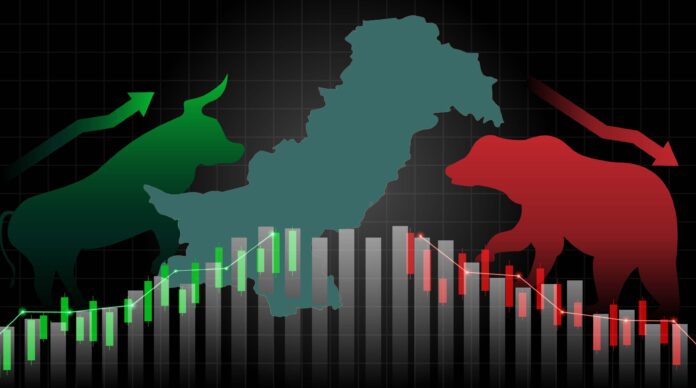The stock market is in for a spin. No matter what happens on the 8th of February the Pakistan Stock Exchange (PSX) will react in response to the country’s general elections as it does to any large or small event in the country.
Because the stock market represents perceptions of the economy, major events in the country have an impact on whether trading is bullish or bearish. Normally, historic events that might have an impact on the economy come as surprises. Elections, however, are pre-planned events that send tremors through the markets. So with this foresight in hand, can investors make a buck with some educated guessing?
It might help to see what has happened to the stock market in the past following elections.
Since the turn of the century, Pakistan has seen four elections. These elections saw four different parties coming into power. An analysis can be carried out where the returns at the stock market can be considered a month and a week before the elections and compare them to a week and month after the elections have been carried out.
Logic suggests that as there is affirmation and continuity of the democratic process, the market should rise. As political norms are continued, it should see a positive sentiment sweeping into the market. Foreign and local investors would be bullish and the stocks should see an overall rise.
Behavior of Markets
Analyzing the historical stock market data surrounding elections can provide insights into potential market trends, but it’s important to note that past performance is not always indicative of future results. Various factors, including global economic conditions, geopolitical events, and other unforeseen circumstances, can influence market behavior.
In the context of Pakistan’s elections, here’s a general framework for understanding how the stock market might respond before and after elections:
Before Elections:
- Year Before Elections:
- Investors may adopt a cautious approach as uncertainty regarding political outcomes increases.
- The market might experience fluctuations as political parties finalize their strategies and campaigns.
- Month Before Elections:
- Volatility could increase as polls and political events influence investor sentiment.
- Investors may take defensive positions or adopt a wait-and-see approach.
- Week Before Elections:
- Short-term uncertainty might lead to increased market volatility.
- Traders may adjust their portfolios based on the latest polls and political developments.
After Elections:
- Week After Elections:
- If the election results are perceived positively by investors (indicating political stability and continuity), the market may experience a short-term rally.
- Initial market reactions may be influenced by the formation of the new government, economic policies, and political stability.
- Month After Elections:
- Investor confidence may further solidify as the new government settles in.
- Market trends may align with the perceived economic and political direction set by the new leadership.
- Year After Elections:
- Long-term market trends may begin to emerge as the government implements policies and economic reforms.
- Foreign and local investors may gain more confidence, leading to sustained market growth.
It is important for investors to conduct thorough research, consider a diverse range of factors, and, if possible, seek advice from financial experts when making investment decisions around election periods. Additionally, markets can be unpredictable, and caution should be exercised.
Elections of 2002
Elections of 2002 marked a pivotal juncture in Pakistan’s political landscape. Held on the 10th of October 2002, these elections were prompted by a Supreme Court directive to then-President Musharraf, compelling him to legitimize his coup through this democratic exercise. The outcome witnessed the Pakistan Muslim League (Q) emerging victorious, forming a coalition government at the center.
As the curtain rose on the year 2002, the stock market index commenced trading at 1,273. By the time the elections unfolded, the index had already surged from its starting point, reaching 2,067—a remarkable increase of 77% within the year. A month preceding the elections, returns registered at approximately 4.4%, with the week immediately prior witnessing returns at 3.09%. Following the electoral event, returns experienced a brief dip to less than 1% one week after, only to rebound impressively to 5.85% over the subsequent month.
This narrative aligns with the paradigm that elections, ushering in a new government, coincided with positive market returns. This surge amounted to an annualized return of over 60%, mirroring the upward trajectory witnessed prior to the elections. Expanding the analytical horizon reveals an astounding market return of almost 100% from the time of the elections.
A necessary caveat underscores the principle that correlation does not imply causation. The market is a complex ecosystem, influenced by a myriad of factors that contribute to its fluctuations. This analysis, however, serves as a historical compass, offering insights into the market’s direction at distinct intervals post-elections. While not prescriptive, it provides a nuanced understanding grounded in historical trends, guiding stakeholders in navigating the complex interplay of political transitions and market dynamics.
Elections of 2008
Elections of 2008 were held on the 18th of February. This electoral episode witnessed the ascendancy of the Pakistan People Party to power, necessitated by President Musharraf’s resignation, thereby facilitating the transfer of power to a democratic framework.
In the preceding year, the KSE 100 index exhibited a robust 26% return, a figure that tapered to approximately 3% a month before and 2.5% a week before the elections. The backdrop leading to these elections was marred by protests and chaos following the assassination of Benazir Bhutto, an event that had a dampening effect on pre-election returns.
Post-election, the one-week return rebounded to around 4.2%, only to see a subsequent increase to 5% a month later. However, the year following the elections witnessed a stark downturn with a return of -60%, attributed to the 2008 stock market crisis and the subsequent freeze on the KSE from August to December 2008.
Elections of 2013
Elections of 2013, held on 11th May, marked a paradigm shift as democratic power transitioned smoothly, with Pakistan Muslim League (N) assuming the majority at the center. Characterized by political and economic stability, the positive sentiment permeated the stock market, translating into substantial returns. A year before the elections, returns stood at an impressive 38%, a figure that moderated to 6.3% a month before and 3.6% a week before. Post-election, returns in the week after remained steady at 3.1%, escalating to 11% a month later. The year following the elections maintained the upward trajectory with a return of 42%.
Elections of 2018
The most recent elections in 2018, conducted on 25th July 2018, culminated in the victory of Pakistan Tehreek-e-Insaaf. This electoral episode further bolstered democratic and political values by strengthening the process of transition of power. The year before the elections witnessed a return of around -11%, while a month and a week before, returns were less than 1% and 3.5%, respectively. Post-election, the market experienced a surge of 5.3% in the week after, settling at 3% a month later. However, the year after the elections saw a downturn, with the market losing value at -22%.
Amidst a prevailing bearish trend in the market, characterized by corrections and negative sentiments persisting until 2022, it’s crucial to contextualize returns within the broader market direction. Nevertheless, on average, the data suggests a post-election buoyancy in the market, with returns up by 6% on average a month after election results are announced. This underscores a discernible impact that elections have on the market
Just history or possible precedent?
As the impending election date approaches, the market is undergoing a surge in volatility, reflecting the heightened uncertainty surrounding the political landscape. Even a mere week before the elections, the political scenario remains in limbo, with concerns mounting over the possibility of election postponement due to a surge in terrorist attacks or escalating political tensions.
Reflecting on the market’s recent trajectory, the index, which triumphantly breached the 66,000 points threshold in December of the preceding year, has encountered a setback, shedding 4,000 points since then, with a substantial 3,000 points lost in the past week alone.
Despite the ongoing publication of ballot papers and robust campaign activities, an air of tentativeness pervades the market, indicating lingering uncertainty that has rendered investors cautious. This hesitancy is also palpable among foreign investors, who, after being net buyers in the market from July 2023 to December 2023, amounting to $71 million, have swiftly liquidated nearly half of this investment in the past month.
According to analysts, however, the majority of net selling was attributed to a single player. “On Jan 19, 2024, Global X ETFs, the New York-based provider of exchange-traded funds, announced the scheduled liquidation of the 19 ETFs including Pakistan ETF, based on an ongoing review process of its product lineup to ensure it meets the evolving needs of its clients,” read a report by Topline Securities.
“At the end of Dec 2023 this ETF had an investment of US$33.23mn in Pakistan. And now based on Jan 30 2024 stats this ETF holding in Pakistan has come down to ~US$2.3mn. Based on these numbers, the selling by this fund is almost over,” it added.
However, if the elections proceed as scheduled on the 8th, a surge in the market index is anticipated. This optimism stems from the elections signaling a return to normalcy and the continuation of democratic norms in the country, thereby catalyzing a boost in bullish sentiment. Moreover, historical data supports the notion that elections typically elicit a positive response from investors, a trend expected to manifest in the week and month following the elections.
A substantial impetus to the market would be the anticipated approval of the next installment of the Stand By Agreement (SBA) with the International Monetary Fund (IMF). As per the agreement, one installment was designated for the departing PDM government, another for the caretaker government, and one for the government that will assume office post-elections. This fulfillment of conditions is poised to trigger a positive market response, potentially clawing back some of the losses of the past month.
Moreover, the key to both market stability and overall economic cohesion in the coming months lies in a seamless transition from the current Stand-By Arrangement (SBA), ending in March, to a long-term extended fund facility with the IMF.
Elections, viewed as positive events by the markets, hold the potential to replicate historical trends in the latest electoral cycle. In the event of elections being conducted in a peaceful environment, the market is poised to echo history and extend a resounding welcome to the incoming government.
However, the trend remains contingent on multiple factors, including the outlook for interest rates and inflation, as well as the risks associated with debt sustainability.


























This is an excellent post I seen thanks to share it. It is really what I wanted to see hope in future you will continue for sharing such a excellent post.
Good information shared
I’m grateful that you shared this great content. That’s exactly what I wanted to see, and I hope you’ll keep writing such great posts in the future.
Hi! This is my first visit to your blog! We are a team of volunteers and new initiatives in the same niche. Blog gave us useful information to work. You have done an amazing job!
Its really a good effort.